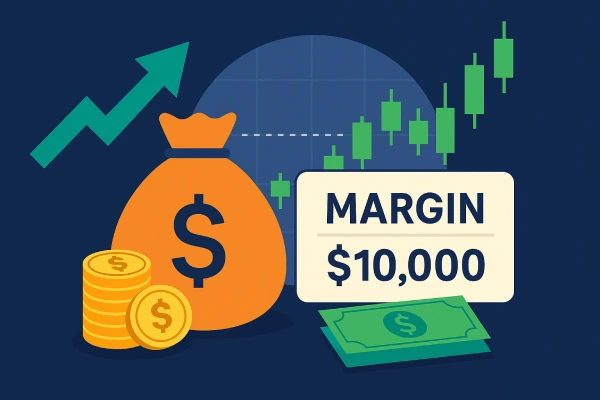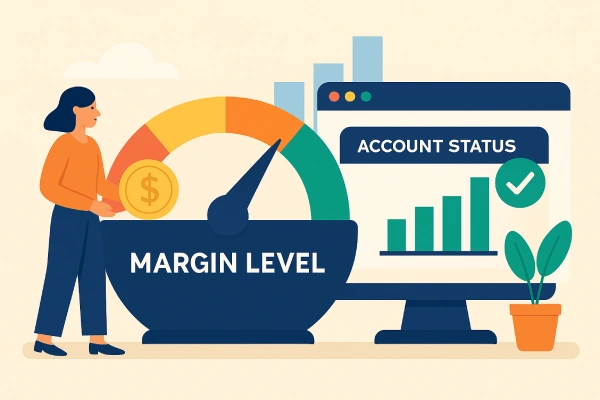The Role of Margin in Forex Markets
The Role of Margin in Forex Markets
"Using margin can enhance your trading potential in forex but comes with trading risks. Understand how margin works in the forex market and how to use it wisely to improve gain and manage loss.""
Wikilix Team
Educational Content Team
9 min
Reading time
Beginner
Difficulty

Could you imagine having the ability to control $100,000 worth of money with just $1,000 in your account? You may think it's magic or impossible, but trading on margin in the forex market gives you just that ability. Perhaps you're a new trader, or you've encountered the term "margin" and aren't quite sure what it means. Understanding how margin works is crucial for forex traders, as it can be the difference between a successful, profitable trade and a losing one. In this article, we will break down what margin is, how margin works in forex trading, and how being smart about using your margin is one of the most fail-safe abilities any forex trader can develop.
What Is Margin in Forex?
At its essence, margin is the amount of money a trader deposits with a broker to establish a leveraged position; in essence, it serves as a security deposit. The broker holds this money as collateral in the event of a loss on the trade.
Margin is not a fee, nor a cost; it is part of your trading capital that is locked up to support an open position. When you trade on margin, you are using leverage - you are using borrowed funds from your broker to exchange a size larger than your risk capital would typically allow.

Leverage and margin are two sides of the same coin
When you see leverage offered as 100:1, 50:1, or 500:1, it is only expressing how much larger your trade can be relative to the margin required.
Here is a quick reference chart to help clarify:
Leverage Ratio | Margin Requirement | Meaning |
50:1 | 2% | You need $2,000 to control a $100,000 trade |
100:1 | 1% | You need $1,000 to control a $100,000 trade |
200:1 | 0.5% | You need $500 to control a $100,000 trade |
500:1 | 0.2% | You need $200 to control a $100,000 trade |
How Margin Works in Practice
Suppose you want to trade EUR/USD with a position equal to $100,000, and you do so with a 1% margin requirement (this is common when you use 100:1 leverage). This means:
- You only need to put up $1,000 of your own money
- The broker will fund the rest, or $99,000
As the price of EUR/USD fluctuates higher or lower, your profit or loss will be based on the entire position of $100,000, not just when you had to put down your $1,000 margin.
That's impressive - and perilous. While profits are amplified, losses will also be magnified.
Margin Level and Account Status
Most brokers will have a margin-level indicator somewhere in your trading account, so you can check to see how much usable margin you have left and whether or not your open positions are safe or put you at risk of a margin call.
Formula:
Margin Level (%) = (Equity / Used Margin) × 100
Here's how margin levels are usually interpreted:
Margin Level | Status | Explanation |
Above 100% | Safe | You have enough equity to support open trades |
Around 100% | Warning Zone | You're getting close to a margin call |
Below 100% | Margin Call Risk | Broker may start closing positions automatically |

What is a margin call?
A margin call occurs when your equity falls below the required level to maintain your open positions. This usually happens when your trades go against you and are pushing you into losses and reducing your equity.
Suppose:
- Trade amount: $100,000
- Margin used: $1,000
- Losses grow to $950
- Your equity is $50
- Your margin level is reduced to 5%.
In this example, your broker may issue a margin call, or automatically sell, close, liquidate, or otherwise offset your position to limit their loss.
Free margin vs. used margin vs. equity
Let’s define the terms:
- Used Margin - The amount currently being used or locked up to keep the open position(s) active.
- Free Margin - The available money in your account that can be used to open a new position.
- Equity - Account balance + unrealized profits (or losses) from open trades.
Here’s an example table:
Term | Definition | Example (USD) |
Balance | Your original funds | $5,000 |
Open Trade Loss | Unrealized loss from current trades | -$500 |
Equity | Balance + Loss | $4,500 |
Used Margin | Margin used to open positions | $1,000 |
Free Margin | Equity – Used Margin | $3,500 |
Margin Trading Risks in Forex
Using margin when trading can maximize your profits, but also includes risks. Here are the primary risks:
1. Increased Losses: Losses will always be calculated on the entire trade value, not only the margin that is used on the trade.
2. Quick Liquidation: You can have a position automatically closed by a broker if your account's equity falls below the required margin level.
3. Overconfidence: The ability to trade prominent positions with minimal cash can create the wrong perception of risk.

Recommendations for Using Margin Responsibly
To avoid additional risk:
- Keep leverage low until sufficient experience is developed.
- Always use stop loss orders to eliminate the chance of downside risk.
- Never risk more than 1–2% of your trading account on any single trade.
- Monitor margin levels regularly.
- Be very clear about your provided margin leverage and stop-out level from your broker.
Conclusion
When appropriately used, margin can be a great ally in forex trading. It can provide access to larger trades, a greater diversification in strategy, and increased returns. However, it can just as easily obliterate your account with a lack of discipline. So what are the takeaways? To learn how margin works, understand the risks, and trade with a plan, as margin is not just borrowing money; it is borrowing trading power.
What's Next?
Keep building your knowledge with our structured learning path. Each section builds upon the previous one.
This is the first section
You're at the beginning of your journey!
This is the last section
You've completed this course!
